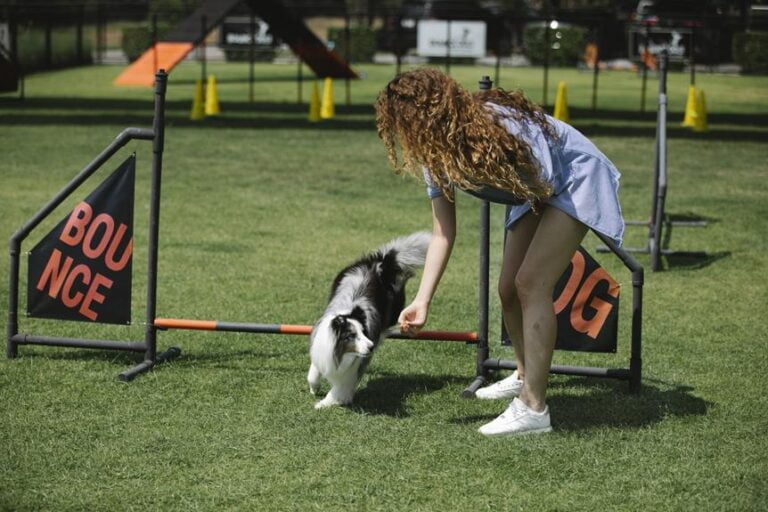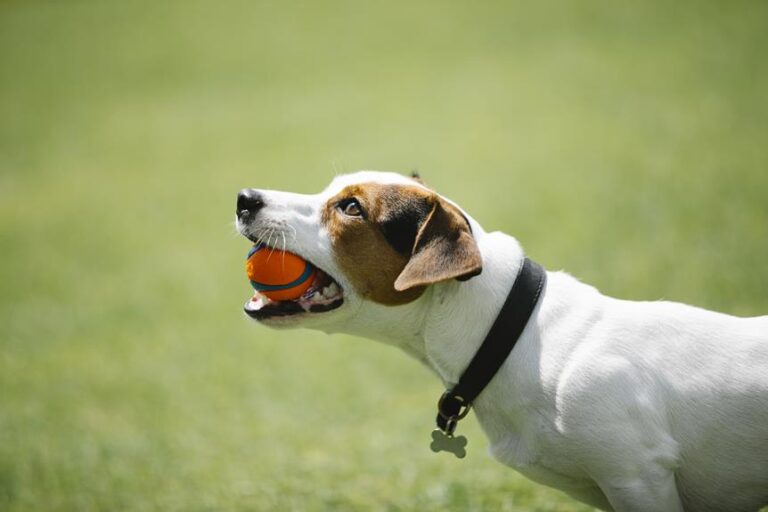Clicker Training – Master Obedience and Behaviour With Clicker Training
In the realm of pet training, one method has taken the world by storm – CLICKER TRAINING.
This ingenious technique, often hailed as the key to mastering obedience and behaviour, offers a seamless communication channel between humans and their furry companions.
By harnessing the power of positive reinforcement, clicker training has proven to be an effective and enjoyable approach for shaping desired behaviours.
In this article, we will delve into the basics, tools, and advanced methods of clicker training, empowering you to become a master of obedience and behaviour.
Key Takeaways
- Clicker training is a positive reinforcement method that uses a click sound to signify correct behaviour and reward the animal.
- Consistency and repetition are essential in clicker training to help animals associate the click with the desired behaviour.
- Clicker training tools and equipment, such as a clicker, treats, and a target stick, enhance the effectiveness of the training process.
- Clicker training can be used to teach obedience commands and modify unwanted behaviours in pets, using techniques like counter-conditioning, desensitization, and shaping.
Basics of Clicker Training
The basics of clicker training involve using an article determiner to introduce the concept of clicker training in a professional and concise manner.
Clicker training is a positive reinforcement method used to train animals, primarily dogs, by associating a sound, typically a click, with a reward. This technique is based on the principles of operant conditioning, where desired behaviours are reinforced through rewards, increasing the likelihood of the behaviour being repeated in the future.
The clicker, a small handheld device that makes a distinct click sound, serves as a marker to signify to the animal that they have performed the desired behaviour correctly. This instant feedback helps the animal understand which specific action led to the reward, making the learning process more efficient.
To begin clicker training, the first step is to pair the click sound with a reward. This is done by clicking the device and immediately following it with a treat or praise. This association helps the animal understand that the click is a positive signal indicating a reward is coming.
Once the animal understands the connection between the click and the reward, the trainer can start using the clicker to mark desired behaviours. For example, if the goal is to teach a dog to sit, the trainer would click the moment the dog’s bottom touches the ground and then reward the dog with a treat. Through repetition and consistency, the dog will learn to associate the click with the desired behaviour and will be more likely to perform it in anticipation of the reward.
Clicker Training Tools and Equipment
To effectively implement clicker training, it is essential to have the appropriate tools and equipment. These tools will not only facilitate the training process but also ensure that you can effectively communicate with your pet.
Here are three essential clicker training tools and equipment:
- Clicker: The clicker is a small handheld device that makes a distinct clicking sound when pressed. It serves as a marker to indicate the correct behaviour and signal to your pet that a reward is coming. The clicker should be easy to hold and operate for precise timing.
- Treats: High-value treats are an important part of clicker training. They serve as a motivator and reward for your pet when they exhibit the desired behaviour. It is recommended to use small, soft treats that can be quickly consumed so that the training session flows smoothly.
- Target Stick: A target stick is a long, thin rod with a ball or target at one end. It is used to guide your pet’s movements and direct them towards a specific object or location. The target stick helps in teaching your pet to follow commands and perform various tasks.
Teaching Obedience Commands With Clicker Training
To teach obedience commands with clicker training, it is important to establish a clear and consistent communication system between you and your pet. Clicker training relies on the use of a small device that makes a distinct clicking sound when pressed. This sound serves as a marker to signal to your pet that they have performed the desired behaviour correctly.
When teaching obedience commands, such as sit, stay, or come, it is essential to use the clicker as a reinforcement tool. To begin, choose a specific command that you want to teach your pet. For example, if you want to teach your dog to sit, start by saying the word ‘sit’ and immediately clicking the clicker. Follow this with a treat or reward. Repeat this process several times, ensuring that you click and reward each time your pet successfully sits.
Over time, your pet will associate the sound of the clicker with the desired behaviour, making it easier for them to understand and respond to your commands. Consistency is key when using clicker training for obedience commands. Be sure to use the same command word, clicker sound, and reward each time. This consistency will help your pet understand what is expected of them and reinforce the desired behaviour.
With practice and repetition, your pet will quickly learn and respond to obedience commands using clicker training.
Behavior Modification Techniques With Clicker Training
Behaviour modification techniques with clicker training can effectively address and correct unwanted behaviours in pets. Clicker training, with its emphasis on positive reinforcement, can help modify behaviours in a humane and effective manner.
Here are three key techniques that can be used:
- Counter-conditioning: This technique involves associating a positive experience with previously negative or unwanted behaviour. For example, if a dog is fearful of loud noises, the clicker can be used to mark and reward calm behaviour when exposed to low-intensity noise. Gradually, the intensity of the noise can be increased while continuing to reward calm behaviour, helping the dog overcome their fear.
- Desensitisation: This technique involves gradually exposing the pet to the stimulus that triggers the unwanted behaviour, in a controlled and systematic manner. By using the clicker to mark and reward calm and relaxed behaviour during each exposure, the pet can learn to remain calm in the presence of the triggering stimulus.
- Shaping: This technique involves breaking down the desired behaviour into small achievable steps. By using the clicker to mark and reward each small step towards the desired behaviour, the pet can gradually learn and master the new behaviour.
Advanced Clicker Training Methods
The utilization of advanced clicker training methods is essential for achieving mastery in obedience and behaviour. While basic clicker training techniques lay the foundation for teaching simple commands, advanced methods take training to a higher level.
One such method is shaping, where the trainer rewards the dog for gradually approximating the desired behaviour. By breaking down complex tasks into smaller, achievable steps, shaping enables dogs to learn intricate behaviours.
Another advanced technique is targeting, which involves teaching the dog to touch a specific object with a body part, such as the nose or paw. Targeting can be used to teach dogs to open doors, turn off lights, or perform other intricate tasks.
Furthermore, chaining is an advanced clicker training method that involves linking together a series of behaviours to create a sequence. This technique is particularly useful for training dogs for sports or performances that require a combination of actions.
Frequently Asked Questions
How Long Does It Usually Take to See Results With Clicker Training?
Results with clicker training can vary depending on various factors such as the individual dog’s temperament, previous training experience, and the consistency of training sessions.
However, on average, it is typically possible to see initial results within a few training sessions. This is because clicker training uses positive reinforcement to effectively communicate desired behaviours to the dog.
With consistent practice and reinforcement, dogs can quickly understand and respond to the clicker cues, leading to improved obedience and behaviour over time.
Can Clicker Training Be Used for Aggressive Dogs?
Clicker training can be a valuable tool in modifying the behaviour of aggressive dogs. By associating the clicker sound with positive reinforcement, such as treats or praise, the dog can learn to associate good behaviour with rewards.
However, it is important to note that clicker training alone may not be sufficient for dealing with aggression in dogs. It should be used in conjunction with other behaviour modification techniques and under the guidance of a professional trainer or behaviourist.
Is Clicker Training Suitable for Older Dogs, or Is It Better for Puppies?
Clicker training can be suitable for both older dogs and puppies. The effectiveness of clicker training is not dependent on the age of the dog, but rather on the dog’s ability to learn and their motivation to respond to positive reinforcement.
Older dogs can benefit from clicker training as it provides mental stimulation and helps improve their behaviour.
Puppies, on the other hand, are often more receptive to clicker training due to their natural curiosity and eagerness to learn.
Can Clicker Training Be Used to Address Separation Anxiety in Dogs?
Clicker training can be an effective method for addressing separation anxiety in dogs. By associating the sound of the clicker with positive reinforcement, such as treats or praise, dogs can learn to associate being alone with positive experiences. This can help alleviate their anxiety and build their confidence when left alone.
However, it is important to note that clicker training should be used in conjunction with other behaviour modification techniques and under the guidance of a professional dog trainer or behaviourist to ensure its effectiveness and safety.
Are There Any Specific Breeds That Are More Responsive to Clicker Training Than Others?
Certain breeds of dogs may show a higher level of responsiveness to clicker training compared to others. This can be attributed to their inherent intelligence, trainability, and eagerness to please their owners.
However, it is important to note that individual dogs within a breed can vary in their response to clicker training. Factors such as temperament, age, and previous training experiences can also play a role in a dog’s responsiveness to this training method.
Conclusion
In conclusion, clicker training is a highly effective method for mastering obedience and behaviour in animals. By using positive reinforcement and a clicker as a marker, animals can quickly learn and respond to commands.
It is a versatile and humane training technique that can be used for a wide range of animals and behaviours. One interesting statistic is that a study found that dogs trained with clicker methods showed higher levels of obedience and fewer problem behaviours compared to dogs trained with traditional methods.







